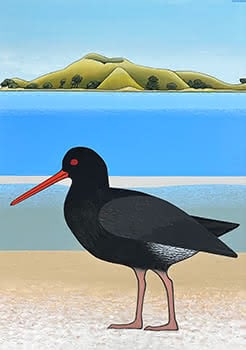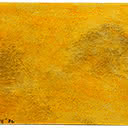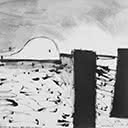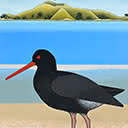Motukorea, Torea-Pango II
106.5 x 75.5 cm
est. $450,000 - 650,000
PROVENANCE Private Collection, Auckland by descent Purchased from John Leech Gallery
The torea-pango, or variable oystercatcher (also known as 'red bill'), makes an early appearance in Don Binney's career as an artist. A pivotal painting from 1964, High Summer, Stewart Island features a stylised torea gliding above the diminutive figure of a bucket-and-spade wielding boy. That painting stands as a double self- portrait in which the artist relates himself both to the bird overhead and the boy digging in the sand. The following year he painted another torea tripping the light fantastic against a backdrop of blue water and grey sky. His attitude to the endemic bird could be playful, mischievous even, as well as respectful.
While the body of the oystercatcher in the 1964 painting was entirely black, the bird in Motukorea, Torea-Pango II, from 36 years later, has a mottled undercarriage. Binney was an ornithologist as well as a painter; he noticed such things and made a point of accurately recording them. At the same time, he was no orthodox bird-painter and in his mature avian pictures he sets about simplifying, flattening and stylising them to his heart's content.
According to his holistic view of the natural world, the bird and the land were in a state of constant relationship and interdependence. It follows that the conservation/preservation of endangered bird species and imperilled natural places were life-long concerns, as was the painterly task he set himself, articulating the space between those two elements. In Motukorea, Torea-Pango II, the bird is almost silhouetted against the pale, atmospheric tonings of beach, sea, island and sky. Instead of the dramatic, angular treatment that characterised Binney's bird paintings of the 1960s, here the torea is calmly rendered and lovingly painted, a study in balance and poise. The rippling water in the harbour is echoed in the bird's plumage. Binney offers us a translucent summer's day, without any overt human presence.
As was usually the case, Binney chose to use the Maori names of both bird and island in the work's title. Often referred to as Browns Island at the time, Motukorea, which translates as 'oystercatcher island', eloquently brings together, in a single word, the two subjects of this painting. Motukorea had established itself as a subject in Binney's art as early as 1970, when Motukorea Painting I and II were exhibited at Peter McLeavey Gallery in Wellington. Around that time and later, Binney made many drawings of Motukorea from Musick Point and other locations, aware of its status as one of the best preserved volcanoes in the Auckland region. Its geological form clearly fascinated him.
While many of Binney's defining paintings are of birds in flight, he made it clear, in his work, as in written and spoken accounts, that ground or beach-foraging birds held equal status in his artistic scheme of things. Motukorea-Torea-Pango II is, at once, an intimate statement of his affection for his subject, and a crystallisation of a life-long concern for, and aesthetic engagement with, both birds and islands.
Gregory O'Brien
These related paintings are reproduced in Don Binney-Flight Path, Gregory O'Brien, Auckland University Press 2023: High Summer, Stewart Island, p.27; Torea, p.364; Motukorea Painting II, p.372 While the Stewart Island oystercatcher is completely black, oystercatchers from regions north of there tend of have a mottled or white underbelly (as they do in most of Binney's torea paintings).





